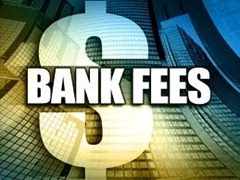 Take a step into your metropolitan “downtown” district. Take notice of the largest buildings in that district. Whose names are on those buildings? Shocking that they usually are names of very large banking institutions! Interesting how banks who seem to have very large physical presences, have some of the highest fees for banking.
Take a step into your metropolitan “downtown” district. Take notice of the largest buildings in that district. Whose names are on those buildings? Shocking that they usually are names of very large banking institutions! Interesting how banks who seem to have very large physical presences, have some of the highest fees for banking.
Below is a chart of the 16 banks with the most U.S. deposits, and how much they made in fees on these deposit accounts during 2008. The right-most column is a calculation of fees per $100 in deposits, and the list is sorted by this metric. (Deposits and fees are in thousands of dollars.)
|
Bank Name |
U.S. Deposits |
Account Fees |
Fees Per $100 |
|
Bank of America |
$754,919,971 |
$10,857,344 |
$1.44 |
|
US Bank |
$145,018,465 |
$1,597,263 |
$1.10 |
|
Wells Fargo Bank |
$308,404,000 |
$3,178,000 |
$1.03 |
|
Regions Bank |
$89,223,072 |
$862,701 |
$0.97 |
|
Fifth Third Bank |
$72,135,041 |
$595,034 |
$0.82 |
|
SunTrust Bank |
$113,436,778 |
$904,842 |
$0.80 |
|
RBS Citizens Bank |
$94,364,954 |
$716,435 |
$0.76 |
|
BB&T Bank |
$89,122,999 |
$674,417 |
$0.76 |
|
PNC Bank |
$88,175,082 |
$574,713 |
$0.65 |
|
TD Bank |
$76,475,518 |
$446,954 |
$0.58 |
|
Chase Bank |
$695,497,000 |
$3,976,000 |
$0.57 |
|
Keybank |
$64,220,946 |
$365,043 |
$0.57 |
|
Capital One |
$76,939,943 |
$354,905 |
$0.46 |
|
HSBC Bank |
$85,562,607 |
$228,110 |
$0.27 |
|
Citibank |
$240,545,000 |
$638,000 |
$0.27 |
|
ING Bank |
$71,769,528 |
$0 |
$0.00 |
I find it interesting how the bank with one of the largest physical presences (Bank of America) as well as some of the highest fees is also in the most trouble. A simple Internet search of Bank of America will reveal a plethora of unsavory articles about this behemoth.
When looking at these numbers, it’s obvious that banks that have large “brick and mortar” presences such as Bank of America have the highest fees. Banks whose presence is largely internet based (such as ING Citibank and HSBC) have some of the lowest fees around.
Nevertheless, it’s clear that when comparing fees for savings accounts and checking accounts, not all banks are created equal, so customers should look closely and weigh the fees, features, and conveniences of each bank to figure out the best fit for them.
According to FDIC data, account fees include:
- Monthly maintenance charges
- Deposits and withdrawals
- Early account closings
- Inactive accounts
- Insufficient funds fees
- Stop payment fees
- Certifying check fees
- Other services
Small Is The New Big
While doing a search of ING’s website, they don’t have “branches”, they have “cafés”, a whopping 7 of them! The majority of their business is done over the internet, phone, and mail. Now I’m not touting ING’s services for publicity sake, I’m trying to make a point that the bank with the tallest buildings may not be your best choice. With the advent of the internet and websites such as this, there really is no excuse to not get access to the bank which is truly a match for you and your individual needs and budget.
There are also “loop holes” with other banks such as Chase, where if you open a Chase Premiere checking account along with a Chase Business checking account, you can escape many of the common fees other banks charge.
Research, knowledge, and being pro-active for your own behalf are really what will save the day in the never-ending quest for free banking. Online resources such as www.FDIC.com can be very beneficial in determining what banking institution is right for you.
Compare the Nation’s Highest Savings Rates with FDIC Insured Banks on the Savings Rates Comparison Chart
